O'Brien Copper D whistle Review
(Review written June 2004)
- Preface
- This is a review of the O'Brien copper whistle. These have been sold on Ebay since about March 2004, according to Mr. O'Brien, and at local music stores before then. He posted about them on The Chiff and Fipple message board and so I wrote to him and offered to review his whistle. Mr. O'Brien accepted, and I played whistle #280 for about 3 weeks. I took it to session and let a couple of the whistlers there noodle on it. I also took it to Scarborough Faire and let Eric the Flute Maker's apprentice look at it, as well as the lass that was working the booth with him, since I've known them both back from when I was doing the faire in Houston. I didn't really like the whistle much, and voiced my concerns to David, and he sent me a new whistle (#315) shortly thereafter, tailored more to my liking.
- At a Glance
- Whistle Reviewed
- O'Brien Copper D whistle
- Models Available
- various keys in copper
- How Acquired
- Product sample from manufacturer
- Construction
- Copper plumbing, like you might get at a home improvement store. Wooden fipple (the first one had a clear lucite fipple).
- Price at Time of Review (in US Dollars unless otherwise noted)
- $65.00 Canadian dollars
- Available From
-
O'brien Pennywhistles or try your luck on Ebay, where I regularly see him selling them.
- Appearance
- When I made my first copper whistle (I've only made 2), I found some plans on the internet that mentioned how to make them out plumbing and joiners that you might get at a store like Home Depot. Then I modified those plans to suit myself. I don't know if Mr. O'Brien used the same plans as a base, but it wouldn't surprise me. That said, his whistles are slightly more professional looking than the two I made. Here are the particulars:
-
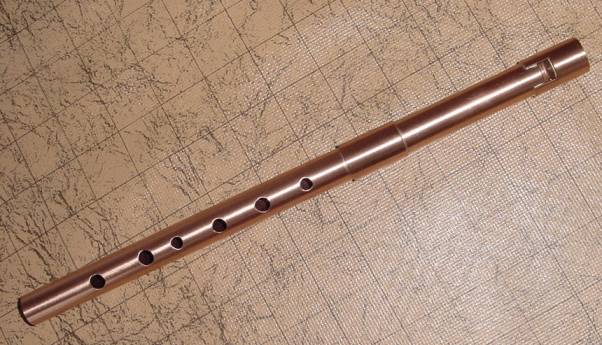
Here's an overall view of the whistle. The mouthpiece and tuning slide are made from copper plumbing joiners, and the rest of the whistle is made from standard copper tubing. As a side note, Elfsong whistles seem to use this same type of copper joiner in their construction. I can't say for sure, though, as I only have pictures to go by.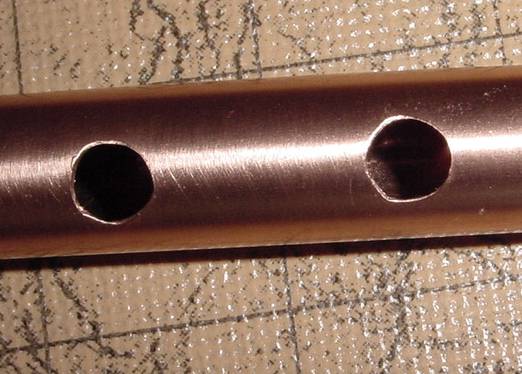
Here's a close-up of the whistle holes. They're a little uneven. I'm not sure how they were made, but I would guess a press drill. Hand drilling produces a much more ragged hole, as I can attest to from personal experience. I imagine that they'd look more smooth if the last bit of fine-tuning was reamed in with some kind of conical reamer. But for all that, they don't feel bad, and serve the purpose.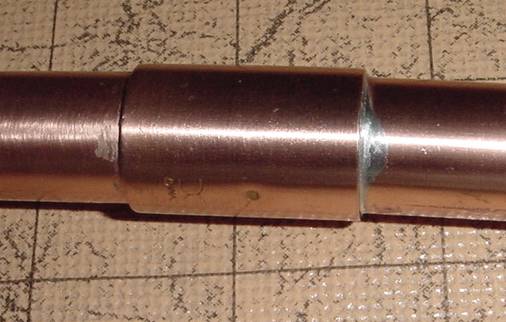
Here's a shot of the solder. You can see it in a few places, but here you can see a good shot of it. The entire mouthpiece appears soldered together, which makes it pretty secure. David says that he uses lead-free solder, which stands to reason.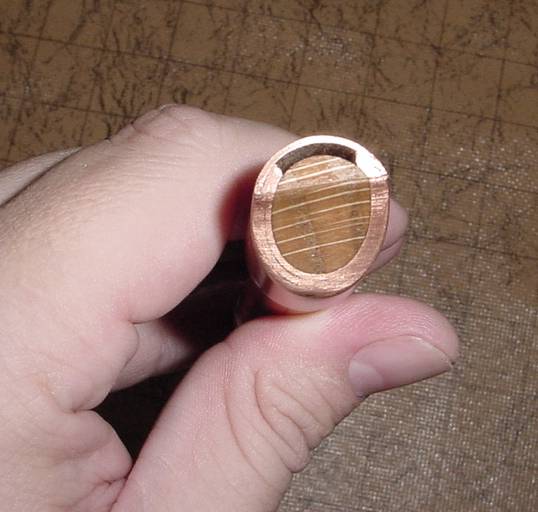
Here's an end-on shot of the fipple. In the first one I got, the windway construction was pretty uneven. This one looks like it's had more attention to detail. I used a hacksaw to cut my mouthpiece angle and it took me forever. It looks like David used something a bit more professional. In any case, no complaints here.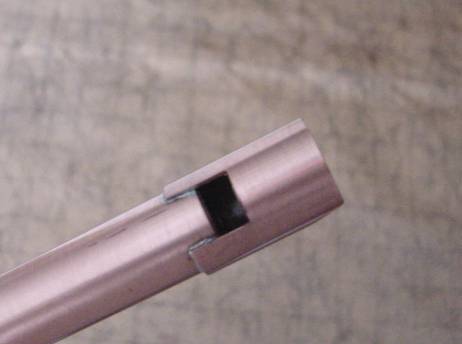
Here's a close-up of the mouthpiece/head region. In the first one, the windway was awfully wide and short. More so than any whistle I'd ever owned. I imagine that accounted for the ultra-quiet, ultra-breathy features I didn't like. This windway is a little narrower, and a little taller. Lastly, a word about the labium ramp: There isn't one. That "blade" is the end of the copper pipe where it was cut with pipe cutters or something. It hasn't been sharpened, thinned, or worked in any way. I was quite surprised it made a sound at all after looking at it. But it works!
- Playing Characteristics
- The first whistle I had was extremely quiet and breathy with a weak bell note, and I didn't like it. This one has a lot stronger character, but still with a tiny touch of breathiness that adds to it's character, in a Clarke-whistle-like way. This tells me that if you have some special characteristics you want out of a whistle, Mr. O'Brien might be able to voice a whistle to your specifications. He was extremely responsive to my needs. The first one I owned really required playing with the whistle stuck straight out from your mouth, and the second one likes to be played that way as well, but it isn't as critical.
-
Sound clips of the whistle:
some random Breton An DroVolume: This whistle is moderately loud. The first one was way too quiet--it couldn't be heard in a near empty bar with no other musicians playing. This one is much better, and I expect it will hold it's own in sessions.
Responsiveness: This whistle is fairly responsive. It allows me to execute cuts and rolls without a problem.
Tuning: This whistle is in tune at A=440 with proper breath control when the whistle is cold. The only complaint here is that the D is a wee bit sharp (15 cents) using the same breath as the rest of the notes, so you have to come down a little for that one note. But since it can be blown into tune without too much lung gymnastics, it's just an idiosyncrasy that you can get used to. All whistles have them.
C-natural: OXXOOO produces a slightly flat C-natural with the expected breath requirements. OXOOOO is much better.
Hole size and placement: This whistle has holes are average sized. Hole positions are similar to the Clarke Sweetone in size and placement. I don't see it as an issue for anyone.
Air volume requirements: Slightly Below average. After narrowing the windway, I find I can get a lot out of a breath on this whistle. The first one took a lot more air.
Air pressure requirements: Average. No super strong push required.
Clogging: Copper tends to collect condensate quite a bit, and this one's no exception. The first one was much better at this, but I imagine that it's because of how much air was whooshing through that wide windway. This whistle will definitely require some anti-condensation measure.
Misc Notes: This whistle really likes you to stick it straight out of your mouth and blow straight down the windway, and David confirmed this characteristic with me in correspondence. No playing at an angle with it stuck in the corner of your mouth, like I usually do.
- Summary
- For the price (about $50 US dollars) I was hoping for something a little less homemade looking. I think his nickel-plated ones look better, based upon some close-up pictures I've seen. I also wish it wasn't so particular about what angle you put it in your mouth. Otherwise, not a bad little whistle.